The French like to make things difficult. And the crowds that troop down to Roland Garros for the French Open certainly fulfill that adage beautifully.
The people here like to cheer for their local players, as spectators all around the world do. But there’s a certain derisive quality to their cheers that makes any opponent of a French player feel alone and unwanted – as Thomaz Belluci found in his late match against Lucas Pouille.
This is a place where the people won’t take any shit from anyone – not even their own fellow spectators. During the match between Novak Djokovic and Joao Sousa, one woman enthusiastically started chanting “Sousa! Sousa! Sousa” as she tried to gee him up in what looked like a hopeless cause. I’m guessing she expected others to join in, so that the underdog would get his moment in the sun.
Instead, her chants were met with a stony silence, which was followed by a bout of contemptuous laughter at her naivete. Of course she should have known better.
It was an eventful first day of my first visit to Paris for the French Open, to say the least. Here are the most interesting sights and sounds I was lucky enough to witness:
It’s all about court positioning
We often like to say that aggressive players propsper because they stand closer to the baseline than their opponents. The full reality of that statement can best be gauged when you are at the stadium – especially if your seat is along the length of the court (i.e. directly facing the chair umpire).
Venus Williams struggled a little against Kurumi Nara at the start of their second round match today. But from my vantage point in the media box, it was hard not to see that Nara was always going to face an uphill task.
At first I thought the seat positioning was terrible; I’d always preferred sitting along the shorter sides of the court. After all, that’s the view that you get to see on TV, and that’s what we’re all most comfortable with.
But when you sit behind the umpire, you can see how much of a difference the court positioning of a player can truly make.
In almost every rally today, Venus stood at least a foot closer to the baseline than Nara, and that helped her take control of the point with disconcerting ease.
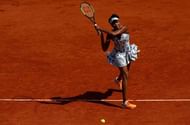
Always looking to step inside the court, that Venus Williams
Nara defended brilliantly on occasion, but since she was constantly being pushed behind, she struggled to make much of an impression whenever she tried to attack. When you are going backwards, you have to exert double the amont of force to create any forward momentum. And anything that requires twice the amount of effort, also involves twice the chance of failure.
When Nara tried to impart more pace on the ball, she often found the net – simply because she didn’t have enough forward momentum. And Venus being the pro that she is, was only too happy to take advantage of that dynamic.
The American bossed her opponent around to register a comfortable win, and is suddenly looking like one of the favourites to win the title. In a crazy women’s draw, could things get any crazier than Venus winning her first Roland Garros title, 15 years after she last reached the final?
Dominic Thiem is a freak of nature
On TV, Dominic Thiem’s groundstrokes look thoroughly impressive. But from a courtside perspective, they look downright unfair.
He was on Suzanne Lenglen today for his match against Simone Bolleli, where the media box positioning is the exact opposite of Chatrier – on Lenglen, I was seated directly facing the players. Not only that, but the media seats on this court are also just four rows away from the ground. That helped me appreciate the force of Thiem’s baseline bullets liked I’ve never appreciated anything before.
It’s not just the pace he generates off the ground, of course. It’s the combination of pace and spin that makes his shots look practically impossible to retrieve.
As I’ve often said to anyone who’ll listen, Thiem may have problems with his longevity because of how many matches he plays, and also because of how much effort he exerts in every shot of every point of every match that he plays. He throws his whole body weight behind his forehand as well as his backhand, and on several occasions I saw both his feet lift off the ground – on a normal rally shot.
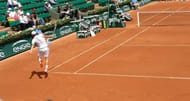
The Dominic Thiem backhand in full flow
I’ve often wondered, while watching on TV, where he gets all his power from. While Thiem is fairly well built, he isn’t among the tallest players on tour, nor is he the most muscular. Today, I got my answer: with his huge backswing and huger follow-through, Thiem never takes any half-measures. He’s always committed to blasting the ball into oblivion, no matter what position he is in, and he has the hand skills to do it.
When it comes off, it looks spectacular. No player bar Stan Wawrinka can draw as many oohs and aahs from the crowd as Thiem does with his backhand. And no player bar Juan Martin del Potro can vaporize a ball the way Thiem does with his forehand.
When the Austrian constantly hammering away from both wings like that, can anyone say with conviction that he is not a future French Open champion?
Thiem can afford to play like this now, because he’s young and fit and supposedly doesn’t have a care in the world. And I hope for his sake that his style does yield him a few Majors eventually. He’s already made a habit of giving the crowd their full money’s worth, so it’d be nice if he got something in return.
The normal rules don’t apply to Rafael Nadal
I said above that aggressive players like Venus Williams take control of the proceedings by stepping into the court and hitting the ball on the rise. But that rule doesn’t apply to Rafael Nadal. More specifically, it doesn’t apply to Nadal on clay.
A little context: I spent the good part of Nadal’s match against Robin Haase today trying to get the perfect shot of the Spaniard sprinting up to the net and digging out a drop shot. But fate had other plans; every time Haase attempted a drop shot, either it would limp into the net or Nadal would give up the chase because the shot was too good. So instead of getting pictures of Nadal sprinting, I ended up with a whole bunch of photos of him hitting his famed forehand.
As I was flipping through the Nadal forehand pictures at the end of the day though, I couldn’t help but notice that a majority of them were hit with him seemingly falling over backwards. Even the forehands that went for winners were struck with Nadal backpedaling behind the baseline, having little to no forward momentum.
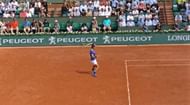
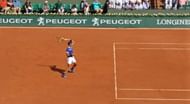
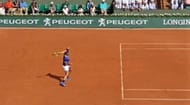
How does he do that? When all other players – of which I saw a live example in the form of Kurumi Nara earlier in the day – struggle to attack when they are being pushed behind, how does Nadal hit winners at will from the same position?
The crazy topspin helps. And so does the Spaniard’s immense core strength. Nadal is not unlike Thiem in that he can create something that ordinary humans can’t, by virtue of being a freak of nature.
Nadal doesn’t always need forward momentum to take control of a point, because he can physically bully every other player in the world – at least on clay. He does that by snapping his wrist like a weapon of mass destruction, which helps him impart insane torque on the ball that takes it up and away from the opponent.
Of course, not everyone can do that. Not everyone is Rafael Nadal.
As precarious as this strategy may sound, Nadal has used his unique strengths to craft a 13-year-long career and a haul of 14 Grand Slams. Something tells me Thiem would consider himself blessed if he ends up achieving a fraction of that.
What is the foot injury that has troubled Rafael Nadal over the years? Check here
